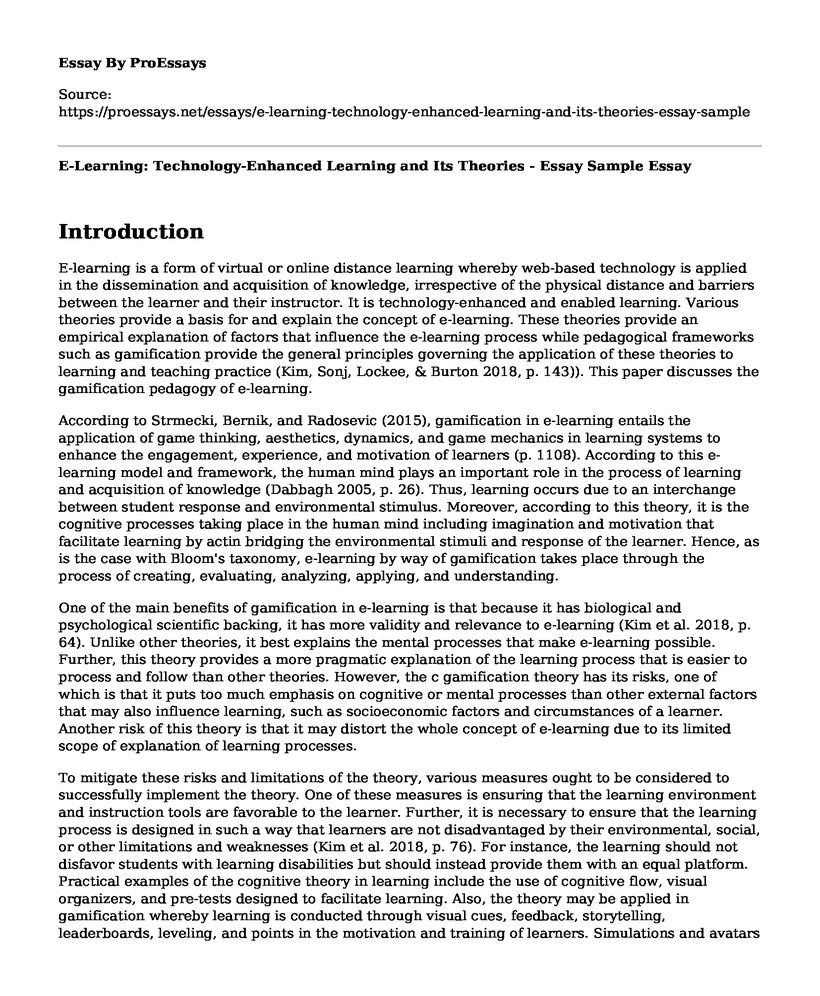Introduction
E-learning is a form of virtual or online distance learning whereby web-based technology is applied in the dissemination and acquisition of knowledge, irrespective of the physical distance and barriers between the learner and their instructor. It is technology-enhanced and enabled learning. Various theories provide a basis for and explain the concept of e-learning. These theories provide an empirical explanation of factors that influence the e-learning process while pedagogical frameworks such as gamification provide the general principles governing the application of these theories to learning and teaching practice (Kim, Sonj, Lockee, & Burton 2018, p. 143)). This paper discusses the gamification pedagogy of e-learning.
According to Strmecki, Bernik, and Radosevic (2015), gamification in e-learning entails the application of game thinking, aesthetics, dynamics, and game mechanics in learning systems to enhance the engagement, experience, and motivation of learners (p. 1108). According to this e-learning model and framework, the human mind plays an important role in the process of learning and acquisition of knowledge (Dabbagh 2005, p. 26). Thus, learning occurs due to an interchange between student response and environmental stimulus. Moreover, according to this theory, it is the cognitive processes taking place in the human mind including imagination and motivation that facilitate learning by actin bridging the environmental stimuli and response of the learner. Hence, as is the case with Bloom's taxonomy, e-learning by way of gamification takes place through the process of creating, evaluating, analyzing, applying, and understanding.
One of the main benefits of gamification in e-learning is that because it has biological and psychological scientific backing, it has more validity and relevance to e-learning (Kim et al. 2018, p. 64). Unlike other theories, it best explains the mental processes that make e-learning possible. Further, this theory provides a more pragmatic explanation of the learning process that is easier to process and follow than other theories. However, the c gamification theory has its risks, one of which is that it puts too much emphasis on cognitive or mental processes than other external factors that may also influence learning, such as socioeconomic factors and circumstances of a learner. Another risk of this theory is that it may distort the whole concept of e-learning due to its limited scope of explanation of learning processes.
To mitigate these risks and limitations of the theory, various measures ought to be considered to successfully implement the theory. One of these measures is ensuring that the learning environment and instruction tools are favorable to the learner. Further, it is necessary to ensure that the learning process is designed in such a way that learners are not disadvantaged by their environmental, social, or other limitations and weaknesses (Kim et al. 2018, p. 76). For instance, the learning should not disfavor students with learning disabilities but should instead provide them with an equal platform. Practical examples of the cognitive theory in learning include the use of cognitive flow, visual organizers, and pre-tests designed to facilitate learning. Also, the theory may be applied in gamification whereby learning is conducted through visual cues, feedback, storytelling, leaderboards, leveling, and points in the motivation and training of learners. Simulations and avatars are examples of areas where gamification is applied in e-learning.
References
Dabbagh, N. (2005). Pedagogical models for E-Learning: A theory-based design framework.
International Journal of Technology in Teaching and Learning, 1(1), pp. 25-44.
Kim, S., Sonj, K., Lockee, B., & Burton, J. (2018). Gamification in e-learning and education: Enjoy learning like Gaming. Virginia: Springer International Publishing, AG
Strmecki, D., Bernik, A., & Radosevic, D. (2015). Gamification in e-learning: Introducing gamified design elements into e-learning systems. Journal of Computer Sciences, 11 (2), pp. 1108-1117
Cite this page
E-Learning: Technology-Enhanced Learning and Its Theories - Essay Sample. (2023, May 15). Retrieved from https://proessays.net/essays/e-learning-technology-enhanced-learning-and-its-theories-essay-sample
If you are the original author of this essay and no longer wish to have it published on the ProEssays website, please click below to request its removal:
- Workers in the Cane Essay
- Infants and Toddlers Learning Space Essay Example
- Socio-Autobiography Essay
- Applying Critical Thinking in Solving Cloud Computing Problem
- Life Events and Future Goals: A 25-Year-Old's Journey - Essay Sample
- Essay Sample on Early Childhood Education: Benefits for Kids and Communities
- Essay Example on Gaining Knowledge in Campus: Benefits and Challenges







